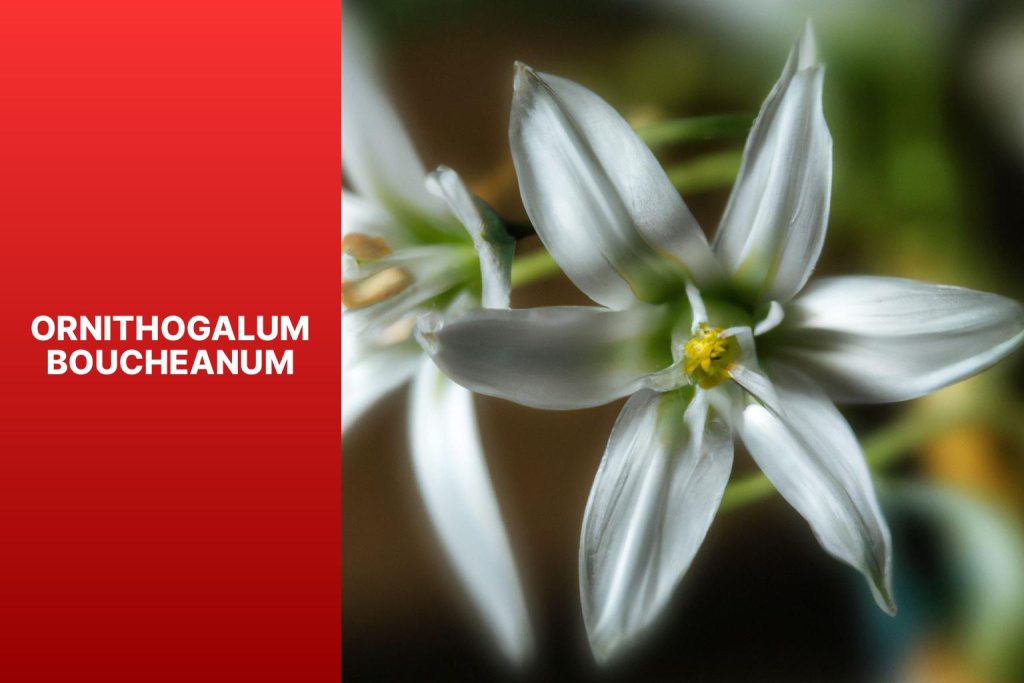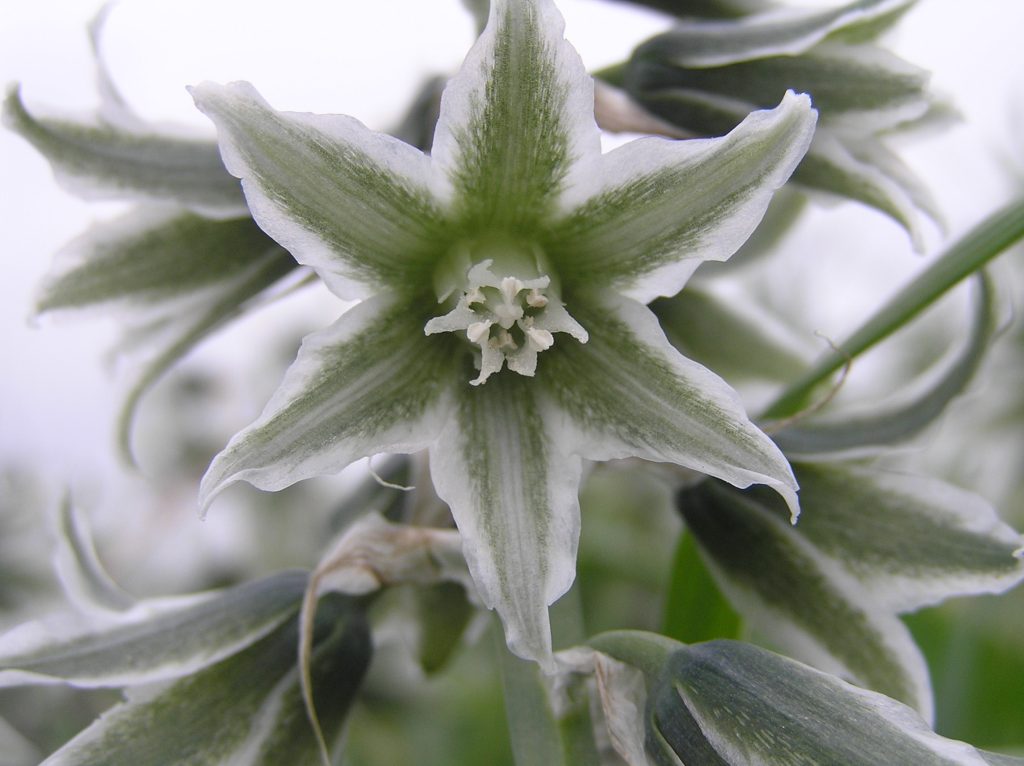Hello, dear readers, and welcome to this article. I will introduce you to Ornithogalum Boucheanum. What kind of plant is Ornithogalum Boucheanum? In which season and where does it grow? What are its physical characteristics? How much does it grow? How is it planted in the soil? What are the maintenance conditions? What are the harms?

How Does Ornithogalum Boucheanum Look When Grown, and How Should It Be Planted?
The flower is white or pale pink, with a star-shaped arrangement. It has six petals, which are slightly reflexed at the tips. The flowers are borne on a tall, slender stem, and they can reach up to 2 inches in diameter.
Ornithogalum boucheanum, also known as Bouché’s star of Bethlehem, is a bulbous perennial plant in the family Asparagaceae. It is native to Central Europe and the Caucasus region. The plant has a stout, 20–50 cm tall stem with 4-6 bright green, linear leaves 0.5–1.5 cm wide. The flowers are white or pale pink, with a star-shaped arrangement. They bloom in spring, from April to May.
Table of Contents
Here are some additional facts about Ornithogalum boucheanum:
- The plant’s common name, Bouché’s Star of Bethlehem, is in honor of the French botanist Jean Baptiste Bouché.
- The plant’s flowers are pollinated by moths.
- The plant’s seeds are dispersed by ants.
- Ornithogalum boucheanum is a member of the lily family.
If you are considering growing Ornithogalum boucheanum, it is important to be aware of its toxicity. The plant should be kept out of the reach of children and pets.
Ornithogalum boucheanum is a hardy plant that is easy to grow. It prefers full sun or partial shade and well-drained soil. The plant can be propagated by division or seed.
Here are some tips for caring for Ornithogalum boucheanum:
- Plant the sprouts in the fall, 4-6 inches deep.
- Water the sprouts regularly during the growing season, but do not overwater.
- Fertilize the bulbs once a month with a balanced fertilizer.
- Deadhead the flowers to encourage more blooms.
- In the fall, after the leaves have died back, mulch the sprouts with a layer of compost or leaf litter.
Ornithogalum boucheanum is a relatively pest- and disease-free plant. However, it can be susceptible to slugs and snails. If you see any pests, you can control them with a non-toxic pesticide.
With proper care, Ornithogalum boucheanum will bloom reliably for many years.
Here are some additional care tips:
- Bouché’s Star of Bethlehem is a cold-hardy plant that can tolerate temperatures down to -30 degrees Fahrenheit.
- The plant is drought-tolerant, but it will appreciate regular watering during the growing season.
- Bouché’s Star of Bethlehem is not fussy about soil type, but it prefers well-drained soil.
- The plant can be propagated by division or seed.
If you are looking for a hardy and easy-to-grow ornamental plant, Ornithogalum boucheanum is a good choice. With proper care, it will bloom reliably for many years.

Medical Uses Of Ornithogalum Boucheanum From History To Present
Ornithogalum boucheanum is a poisonous plant, and there are no known medicinal uses for it. In fact, the plant can be harmful if ingested, and it can cause nausea, vomiting, diarrhea, and other symptoms. In severe cases, poisoning can be fatal.
However, there are some traditional uses of Ornithogalum boucheanum that have not been scientifically proven. For example, the plant has been used in some cultures to treat snakebites and induce labor. It has also been used as a diuretic and a laxative.
It is important to note that these traditional uses are not supported by scientific evidence, and they should not be used without consulting a healthcare professional. If you are considering using Ornithogalum boucheanum for medicinal purposes, it is important to weigh the risks and benefits carefully.
Here are some additional safety considerations:
- Ornithogalum boucheanum is a poisonous plant, and all parts of the plant are toxic.
- The plant can be harmful if ingested, and it can cause nausea, vomiting, diarrhea, and other symptoms.
- In severe cases, poisoning can be fatal.
- The plant should be kept out of the reach of children and pets.
- If you are considering using Ornithogalum boucheanum for medicinal purposes, it is important to consult a healthcare professional.
Damages And Symptoms of Ornithogalum Boucheanum
Ornithogalum boucheanum, also known as Bouché’s Star of Bethlehem, is a poisonous plant. All parts of the plant are toxic, including the bulbs, leaves, flowers, and seeds. The toxins in Ornithogalum boucheanum are similar to colchicine, which is a poisonous alkaloid.
If ingested, Ornithogalum boucheanum can cause a variety of symptoms, including:
- Nausea
- Vomiting
- Diarrhea
- Abdominal pain
- Dizziness
- Confusion
- Seizures
- Coma
- Death
In severe cases, poisoning from Ornithogalum boucheanum can be fatal. If you or someone you know has ingested the plant, it is important to seek medical attention immediately.
There is no specific antidote for Ornithogalum boucheanum poisoning, but treatment is supportive. This may include activated charcoal to help absorb the toxins, fluids to prevent dehydration, and medications to control symptoms.
The best way to prevent poisoning from Ornithogalum boucheanum is to keep the plant out of reach of children and pets. If you have the plant in your garden, be sure to label it clearly so that others are aware of its toxicity.
Here are some additional safety considerations:
- Ornithogalum boucheanum is a poisonous plant, and all parts of the plant are toxic.
- The plant can be harmful if ingested, and it can cause nausea, vomiting, diarrhea, and other symptoms.
- In severe cases, poisoning can be fatal.
- The plant should be kept out of the reach of children and pets.
- If you are considering using Ornithogalum boucheanum for medicinal purposes, it is important to consult a healthcare professional.